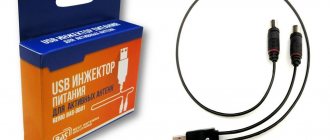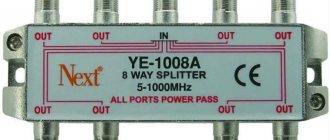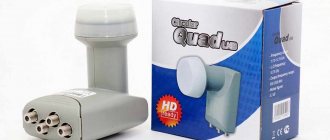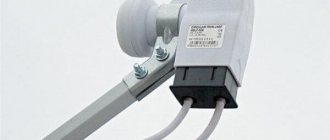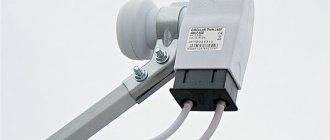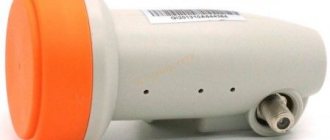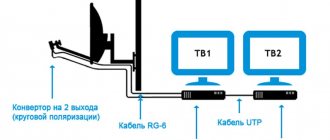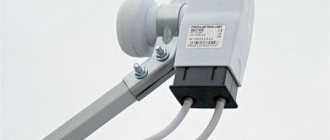There are situations when we need another TV, but we cannot buy it for many reasons. Then the question arises: can the monitor be used as a TV? Or is it possible to connect a TV set-top box to the monitor?
If you have an old computer monitor, then it is quite possible to use it as a TV. This transformation is achieved in several ways. The simplest of them, as you may have guessed, is connecting a monitor to a TV set-top box. You don't need a system unit, keyboard, mouse or various cords for them. You need nothing more than to connect the monitor to the digital TV box directly and use it only as a TV screen.
What is a satellite converter and what is it used for?
The satellite converter provides signal reception, which is reflected from the surface of the antenna and is transmitted in amplified form to the satellite television tuner. This is a complex mechanism that involves the basic laws of physics. You can buy such a converter at an affordable price.
The main characteristic of the converter is additional noise, measured in decibels. When there is little noise, the image on the TV is slightly distorted.
In science, a converter is defined as a receiver that processes a satellite signal. There are actually two devices in a single monolithic unit.
The first device amplifies the signal received from the satellite. Here the level of additional noise plays the main role. At lower values, there will be much less interference, - 0.3 - 0.5 dB.
The satellite converter is also referred to as LNB or low noise unit.
The second device converts wave frequencies. With their help, the signal is transmitted to the receiver or TV via remote access. An offset satellite dish is optimal for signal transmission. Here's a basic explanation of how it all works:
The converter makes the received signal stronger. This helps compensate for losses in the cable that connects the antenna to the receiver.
The receiver introduces its own noise into the signal. They have constant power. The satellite signal from the antenna alone is not strong, so it becomes weaker inside the cable, hence it needs to be amplified.
However, the device introduces its own noise into the signal, so it is important that it is small. The converter can be purchased from different brands.
Operating principle of an antenna converter with two outputs
The device also converts frequency. This is a very important function. From the usual ranges the signal goes into the L range.
This is a rather complex device that consists of several parts. Its design includes an irradiator, a waveguide and the converter board itself.
Converter chip
The feed is a kind of secondary antenna that catches signals sent from the main one.
The converter amplifies and converts a high-frequency signal into a lower-frequency signal, for example, a 12000 MHz signal is converted to a frequency of 1250 MHz. It serves the purpose of preventing the signal from being completely attenuated in the cable. Ideally, the TV receives high-quality, high-definition signals.
The converter also switches polarization. The channels not only have different frequencies, but also different polarizations. Some are polarized vertically, others horizontally.
It is important how the converter is rotated. The directions differ in different places on the earth's surface.
What to pay attention to
As discussed above, the satellite head has criteria such as the number of cable outputs, polarization and frequency spectrum. For television, the winning option would be a receiver that works with circular and linear polarization signals simultaneously; the number of outputs must be taken into account for the number of users.
Consider only second-generation heads that accept radiation with a frequency of up to 12.75 GHz, because Almost all HD channels broadcast at higher values.
Other important criteria include:
- Housing shell. It must be made of reliable insulating material, or a thick cover must be included. Without additional protection, the dielectric is exposed to moisture from precipitation, and the signal noise increases greatly even at the focusing stage.
- Gain. If the antenna is installed on the roof of an apartment building, the gain of the device must be at least 55 dB, because The cable is noisy and long-term transportation along it dissipates radiation. When installed close to the façade, 20 dB is sufficient.
- Noisy. For a satellite head, an acceptable value will be no higher than 0.3 dB. It is worth considering that satellite convectors of the C-spectrum frequency are larger in size and their noise level is higher than that of their analogues.
- Guarantee period. It is important to pay attention to it, because... Satellite TV is purchased for a long time, and the process of installation and searching for the exact direction is labor-intensive.
Finally, it is recommended to pay attention to the energy supply. If possible, preference should be given to 12V devices, because they work from the receiver (or TV) and do not require a separate connection to the network.
What types of satellite dish converters are there?
A converter, more precisely called an LNB, is needed in order to convert the wave frequency “Ku” (10...13 GHz) or “C” range (3.5...4.5 GHz) into 0.95...2.5 GHz, which allows the signal to be transmitted with minimal losses along the cable up to receiver.
This makes it possible to use an inexpensive coaxial cable and give it a length of up to 20-30 meters so that the signal is not lost. TO\
All converters vary in noise. Their diversity is also great in another way.
The following converters are available:
- Converter for “C”.
- Converter for “Ku”.
- Universal".
LNB satellite antenna converter C band
It is necessary to determine in which band, “Ku” or “C”, it is used. The big difference between the devices is their operation in different frequency ranges. The frequency converter works in a wide variety of weather conditions.
The principle of operation of the satellite converter
The converter collects the waves, converts them into signals of electrical origin, which transmit the signal to the receiver. The LNB converter is placed at the focal point of the antenna, where the waves are focused. The signal is amplified in the converter and converted to a lower frequency.
To transfer a signal from C or Ki to the L-band, you need a local oscillator that generates a radio signal. The mixer helps to obtain the third signal, which is the difference of the first two. In the end it works out.
In the Ki band, in the opposite way, the local oscillator frequency is calculated from the frequency of the signal received from the satellite. There is another feature there. It is impossible to transfer the entire Ki-band to the L-band.
Either the converter has one local oscillator and does not cover the entire Ki-band, or the satellite signal goes into the L-band only partially, the bottom or top of the range is used.
The second type of converter is universal; it has 2 local oscillators, the second of which covers the upper Ku band. The ranges are switched using an electronic key controlled by a special signal.
Inside the converter there is a metal structure. The filling of the device is hidden in a metal case, where the output for the F-connector is inserted.
The converter may have a different number of outputs. Sometimes the number reaches eight.
Satellite converter for 2 and 8 outputs
It is very convenient for everyday use. Sometimes there may be several tuners that allow you to optimize the signal for several TVs.
Universal satellite converter
HDMI2AV signal converter or reincarnation of an old CRT TV
Good day to all. Today I want to share with you my impressions of a relatively recent purchase - an HDMI2AV signal converter. In short, this box met all my expectations, but first things first. So, I, and especially my wife, and indeed like every normal person, want to spend a little more time in bed on the weekend. Moreover, you can either just lie around or brighten up this time even more by watching some interesting and educational film or program. But if in the hall and in the daughter’s room there are already televisions with Android TV set-top boxes connected to them, then in the bedroom there was only an old domestically produced picture tube (aka CRT) TV - “Vityaz”, which was more a historical monument than a working one device - not even an antenna was connected to it. This instance looks like this:
Today I want to share with you my impressions of a relatively recent purchase - an HDMI2AV signal converter. In short, this box met all my expectations, but first things first. So, I, and especially my wife, and indeed like every normal person, want to spend a little more time in bed on the weekend. Moreover, you can either just lie around or brighten up this time even more by watching some interesting and educational film or program. But if in the hall and in the daughter’s room there are already televisions with Android TV set-top boxes connected to them, then in the bedroom there was only an old domestically produced picture tube (aka CRT) TV - “Vityaz”, which was more a historical monument than a working one device - not even an antenna was connected to it. This instance looks like this:
In general, it was initially planned to replace it with a more compact (LCD) and modern version, but due to the difficult economic situation, this has not happened yet, and it is unknown when it will happen. 
I also had a tablet - a fake Lenovo, bought for a friend on Aliexpress, but due to certain circumstances, remained with me. Many adversities and trials fell to his lot, but despite this he continued to work day after day until fate, the villain, dealt him the final blow. The performer of the blow was my nephew 
But despite its deplorable appearance, the tablet continued to work. However, due to its complete uselessness, it was thrown into the closet, where it lay for several months, until the idea came to my mind to cross it with, as you already guessed, the same Vityaz TV. The only problem was that the tablet had a connector HDMI, but “Vityaz” could not boast of the ability to receive a digital signal - its interfaces had a composite video input and audio (tulips on the front) and SCART (doesn’t work, I don’t know why
However, due to its complete uselessness, it was thrown into the closet, where it lay for several months, until the idea came to my mind to cross it with, as you already guessed, the same Vityaz TV. The only problem was that the tablet had a connector HDMI, but “Vityaz” could not boast of the ability to receive a digital signal - its interfaces had a composite video input and audio (tulips on the front) and SCART (doesn’t work, I don’t know why ) So the only thing left to do is convert the digital signal to analog . For this I needed that same black box. I ordered it on Aliexpress for $5.68 (now the price has risen a little), the seller sent the parcel with a track, the movement of which can be seen here.
) So the only thing left to do is convert the digital signal to analog . For this I needed that same black box. I ordered it on Aliexpress for $5.68 (now the price has risen a little), the seller sent the parcel with a track, the movement of which can be seen here.
It comes in original packaging, which is a cardboard box with fairly high-quality printing. on its front side there is a window through which our converter is visible, and just below it there is a proud inscription Full HD 1080p. 
On the back of the box there are schematic illustrations of its use.
The converter itself is packed in a plastic blister. In addition, the package includes a small instruction manual and a cable for supplying power to it.
The essence and meaning of this cable is not entirely clear to me, since the device works fine without it. Well, okay, it’s better to have something extra than not have something necessary.
The converter itself is quite compact - its dimensions are about 70x50x20 mm. It is assembled very well; it took a fair amount of fiddling to divide it into two halves. On one side there are three standard tulips: yellow for video, white and red for audio (outputs). On the opposite side there is a full HDMI (input). On the side there is a miniUSB for power supply and a PAL/NTSC mode switch.
And this is what the filling of our box looks like:
The board is one-sided, I have no complaints about its quality. Back side:
There is nothing else interesting in the appearance and design of the converter, which means you can proceed to checking it. We quickly connect everything into one bundle and turn on our TV. It worked!!!
In principle, we can stop there. But somehow the bundle of wires that appeared along with the broken tablet made me very nervous. Therefore, it was decided to make minor design changes to the TV body.
We are preparing a “gentleman’s kit” that we will need to carry out the procedure.
First, let's disassemble the tablet.
In general, from this whole thing we only need a board with a WiFi antenna wire. Disconnect all cables and unsolder the battery. As it turned out during the experiment, when powered from the mains, this basement Chinese works perfectly without a battery, otherwise it would have to supply power both to the board (lowering it from 5V to 4.5V) and to the charging connector. Thankfully I didn't have to do that 
By the way, the heart of our system is ATM7029B - if you see a similar inscription somewhere, avoid it, it’s a terrible brake! But for our not very picky purposes it is quite enough.
We leave the board, hide the battery (it might come in handy later), and throw the rest in the trash.
We arm ourselves with a screwdriver and disassemble the TV. You know, while I was tinkering with this 10-year-old Vityaz, I realized two things: firstly, old TVs have a lot of free space and, if desired, you can hide anything in its case, and secondly, a whole horde of dead insects is hiding there , tons of dust and kilometers of cobwebs o_O.
We carefully clean the whole thing, after which we select a place where we could compactly place all our wealth - for me it’s the back right side.
First of all, we strengthen the heart of our “high-performance” and multifunctional SmartTV system - the board from the tablet. I attached everything with hot glue, it is fixed securely and quickly.
As for the tablet buttons: ON/OFF and volume control. The volume was set to the maximum level, and where the power button is now, a small hole was drilled in the TV body. Of course, you can’t turn it on with your finger, but a toothpick solves all the problems. You can say that this was not a very practical option. Yes it is. But due to the fact that the “tablet” is constantly powered from the mains, you will have to turn it on manually very rarely (unless after an unscheduled power outage).
As I already said, the SCART connector did not work for me, so I will have to wire it to the quick access connectors located on the front side of the TV. To do this, we break out the plugs located just below our board, covering 4 holes (that’s exactly what we need: 3 for transmitting pictures with sound and 1 for connecting power).
Let's start connecting: power, miniHDMI - HDMI adapter, tulips.
We install the converter, an OTG cable for connecting a wireless mouse, connect the HDMI cable and carefully place it so that it does not interfere with anything.
During the process of assembling the TV, it turned out that its case was not as immense as I initially thought, so I had to disassemble the converter again and install it without the case. We check the connections, turn on the “tablet”, and carefully put the TV back together. Can't do without the help of a cat 
We turn it on - everything works. We adjust the image size, install the new necessary software, update the already installed one. There are no problems with operation, nothing overheats (for cooling there are enough holes that were in the TV case initially), everything works properly (tested for 2 days almost 24 hours a day and another 5 days in the mode of watching 1-2 episodes of which - series in the evening).
We adjust the image size, install the new necessary software, update the already installed one. There are no problems with operation, nothing overheats (for cooling there are enough holes that were in the TV case initially), everything works properly (tested for 2 days almost 24 hours a day and another 5 days in the mode of watching 1-2 episodes of which - series in the evening).
Of course, it won’t be possible to run something “heavy” (HD), but watching movies online (FS Videobox), videos on Youtube, torrent TV (TSC) works with a bang, and nothing else from this updated multimedia center required Moreover, this TV model clearly does not support 1080p resolution, nor does it support 720p :(. Of course, it would be possible to take screenshots, but photos are more suitable for this device
Moreover, this TV model clearly does not support 1080p resolution, nor does it support 720p :(. Of course, it would be possible to take screenshots, but photos are more suitable for this device
As for the picture, nothing shakes, the colors are normal. The size is also transmitted proportionally, nothing moves anywhere. Colors are as clear as the TV allows. Unfortunately, I don’t know what resolution is displayed on the screen, and I don’t want to, so as not to get upset :). In general, the converter works well and copes with its direct responsibilities just as well.
In principle, that's all . I think that the purchase turned out to be very successful. With minimal investment, a fairly good result was obtained, which satisfied me 100%. Yes, not Full HD, but the cost is only $6, even less.
. I think that the purchase turned out to be very successful. With minimal investment, a fairly good result was obtained, which satisfied me 100%. Yes, not Full HD, but the cost is only $6, even less.
Thank you all for your attention and time spent. 
How to check the converter for functionality
It is very easy to check the converter for serviceability. If you have problems with the TV's reception of the signal, you need to see if the problem is really with the converter.
First you need to visually check the cable going from the receiver to the antenna to see if it is broken anywhere. If the cable is intact, you need to check the head of the dish, then the contacts with the wires; there is an easier option, namely, change this head and see if the signal has changed. Then you can understand whether the cause of the problem is in a broken converter or in another unit.
How to choose a satellite head and check the satellite antenna converter for functionality, converters for satellite antennas with two, three and four outputs:
Connecting the set-top box to the monitor
Purchasing and connecting a DVB-T2 set-top box to a monitor is a reliable way to miraculously transform a computer display into a television receiver. Modern displays, like televisions, are equipped with built-in speakers and are practically self-contained devices. But if you have a regular monitor (perhaps even a lamp one), then you will need separate speakers - you will connect them to the corresponding connector on the DVB-T2 decoder. It would be great if they had stereo sound. If desired, you can purchase speakers with a remote control.
An external digital set-top box is an independent device that connects to the electrical network, television antenna and monitor. It is controlled using a remote control, just like a regular TV.
The situation with DVB-T2 receivers is such that the manufacturer did not intend to connect them to computer monitors, but only to televisions. At the same time, new monitors, like modern television receivers, are equipped with an HDMI connector, which is present on set-top boxes, while older ones can only be found with VGA and DVI-D.
HDMI to VGA Converter
The options for connecting it to a digital television set-top box will depend on what connectors you find on the display. The following combinations are possible (see table).
| Monitor | Console | Connection method |
| VGA | HDMI | HDMI to VGA converter |
| VGA | VGA to VGA cable | |
| DVI | DVI to VGA adapter | |
| HDMI | HDMI | regular HDMI to HDMI cable |
| VGA | VGA – HDMI converter | |
| DVI | passive adapter or cable DVI – HDMI |
You may be interested in: Connect digital television
How to choose a LNB, what to look for
Noise figure is the main parameter for choosing a converter. It is important to take into account the frequency range, phase noise, current used, and polarity when choosing. The most important components are noise figure and gain. In a good way, the noise figure should be indicated on the packaging.
Specification
If it is not listed, you should not buy the device. At the same time, a low coefficient does not guarantee that the converter will be of high quality. This parameter is tested only in laboratory conditions.
Therefore, it is better to buy devices only from places that have been tested and have proven themselves well. A universal converter can be bought inexpensively on the Internet and in radio parts stores. This is the best option.
How to choose a satellite converter:
I DETECT YOUR AD BLOCKER!
I understand that you cannot turn off your ad blocker.
Simply because I don’t want to change the order of things. But like any sane person, I want to offer a compromise. I GIVE YOU GIFTS! PAY ATTENTION TO ADVERTISING! NO OFFENSE! BE MORE HUMAN TO THE AUTHORS OF ARTICLES! ISN'T IT NICE TO DO SOMEONE GOOD?
INCREASE YOUR PERCENTAGE OF POSITIVE KARMA. WE WILL ALL BE GRATEFUL!
We have a minimum of advertisements on our page. At the beginning of the article and at the end! So it won’t hurt to read and learn something useful!
Whitelist this website or disable your ad blocking software!
THERE WILL BE SPECIAL GIFTS FOR SUBSCRIBERS!
THIS IS EASY AND FREE TO DO. ALSO, GIFTS WILL BE TO ALL FRIENDS WHO DO NOT TURN ON AD BLOCKING! And they pay attention to advertisements. You will find the GIFT above the bottom block (footer), or to make it completely clear, immediately after the comments. Of course, when you disable the blocker. The gift will be updated and have different themes.
A tiny team of authors already thanks YOU for your kindness and understanding of the situation. The advertisements contain useful information.
GOOD LUCK FRIENDS!
A video signal converter is useful if you need to connect a device that only has “tulips”.
For example, an old video camera, a video surveillance system, or a game console, etc. But you need to connect these devices to a modern monitor or TV with an HDMI port.
A device that allows you to convert an analog audio/video signal from the AV interface to digital, HDMI. On the case there is an output resolution switch for HDMI: 720p or 1080p.
This device contains a chip that converts an analog signal to a digital one. As the manufacturer claims, there is no loss of quality during conversion.
The device has a compact size (66x55x20 mm), so it can be easily hidden behind the TV. The converter is powered from any USB port (on a media player, computer, TV, etc.), the corresponding cable is included in the kit.
Supported HDMI output resolutions: - 720p/60Hz, 1080p/60Hz Supported input standards: - PAL, NTSC3.58, NTSC4.43, SECAM, PAL/M, PAL/N Dimensions: 66x55x20 mm Weight: 40g Power: 5V USB HDMI interface , AV Contents: miniUSB cable
Another option is when everything is the other way around.
A video signal converter that allows you to convert a digital audio/video signal from the HDMI interface to analog.
And this, Friends, is for signal transmission via composite “tulips” (RCA). This converter will be useful if you need to connect a media player, computer, tablet, game console, video surveillance system and other modern devices with an HDMI port to an old TV that does not have HDMI, but only RCA tulips (composite input).
This device contains a chip that converts the digital HDMI signal into an analog composite video connector and stereo tulips. The device has a compact size (66x55x20 mm), so it can be easily hidden behind the TV.
The converter is powered from any USB port (on a media player, computer, TV, etc.), the corresponding cable is included in the kit. There is a switch for selecting the PAL/NTSC television system.
Supported HDMI input resolutions: - 640× [email protected] - 480i, 480p, 576i, 576p - 720p, 1080i, [email protected] /60Hz Supported AV output resolutions: - 480i, 576i HDMI 1.3 interface Contents: miniUSB cable
Good luck, Friends!
Specific Models
The satellite dish converter from Tricolor is popular because of its reliability, and you can buy it at an affordable price. It will not cost much, but will provide home owners with a high-quality signal.
Satellite head from Tricolor
ALYNO satellite television has a combined C+Ku converter based on two converters.
It has a dependent output “Ferret direct focus Twin-Twin”, which provides constant signal reception in two ranges at once: C and Ku. Works only in conjunction with the passive multiswitch 4/2. Made for offset antennas. Polyethylene caps.
Converter General Satellite GSLF-51E with waveguide diameter: 40 mm (standard); connector type: 75 F-type is also popular among subscribers.
Galaxy Innovations GI-301 converter is a circular polarization converter. It is very convenient to use in everyday life.
Design and installation on the antenna
Electromagnetic radio waves fall onto a mirror. Since its shape is spherical, the signal falling onto the mirror area is reflected only in a single direction, forming a beam focused at one point.
The necessary device is placed in the “focus” - the satellite converter itself. This beam falls on him. The main elements of the converter are the feed, the waveguide through which the signal travels, and the electronic unit that converts the waves into pulses.
The converter converts frequency, polarization, and provides a high-quality signal. Designed for watching TV in high quality.
Errors during selection and installation, how to avoid them
The quality of the case is often chosen inappropriately.
Workplace - street. During use, the device is affected by temperature changes. Therefore, the device body must be of high quality.
The removable cover from the sun's light must be resistant to radiation. Therefore, you should again choose high-quality material.
Important! Any depressurization of the device will allow atmospheric moisture to enter, which will lead to failure.
The color of the body should not be bright, otherwise it will attract birds that will peck at the bright plastic.
Before setting up, it is important to see how capable the device is of operation.
Important! A working device shows a signal even when the antenna is not tuned to the satellite.


